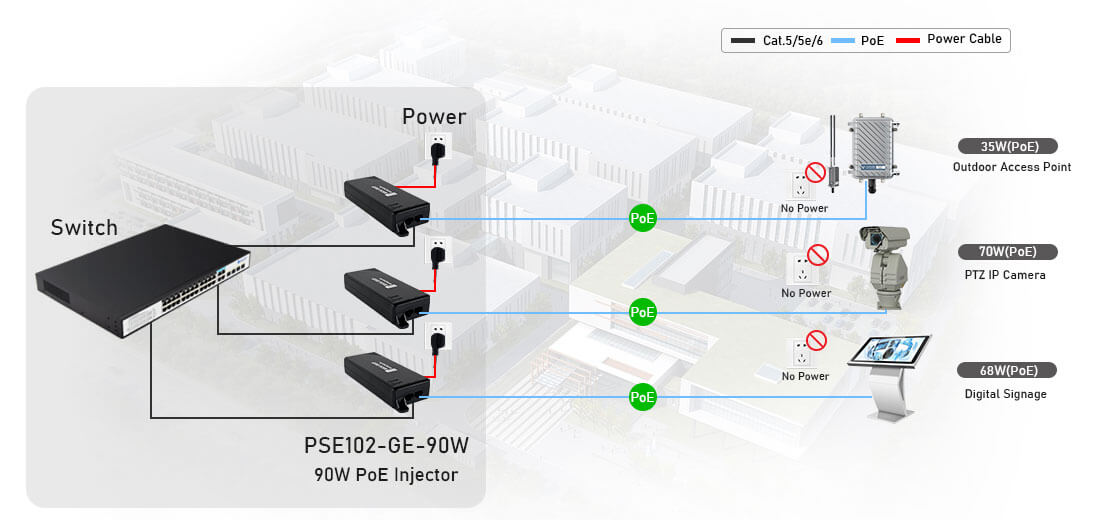
Un injecteur PoE peut-il prendre en charge plusieurs appareils simultanément ?
En général, un injecteur PoE est conçu pour alimenter un seul appareil, et non plusieurs appareils simultanément. Sa fonction principale est d'ajouter l'alimentation via Ethernet (PoE) à une seule connexion Ethernet en combinant l'alimentation et les données dans un seul câble. Cependant, il existe certaines nuances et cas d'utilisation spécifiques dans lesquels plusieurs appareils peuvent être pris en charge, en fonction de la configuration et du type d'équipement PoE utilisé. Voici une répartition détaillée :
1. Injecteurs PoE à port unique typiques
--- Conçu pour un appareil : Standard Injecteurs PoE sont des appareils à port unique qui fournissent de l'énergie et des données à un appareil alimenté (PD), tel qu'une caméra IP, un point d'accès sans fil ou un téléphone VoIP.
--- Limitations d'alimentation et de données : chaque port d'injecteur est conçu pour fournir de l'énergie dans les limites de la norme PoE spécifique qu'il suit (par exemple, 802.3af = 15,4 W, 802.3at = 30 W, 802.3bt = 60-100 W).
--- Nombre de ports physiques : les injecteurs à port unique ont généralement une entrée pour les données (provenant d'un commutateur ou d'un routeur) et une sortie pour l'alimentation et les données combinées vers l'appareil connecté.
Pourquoi le port unique est-il standard ?
--- Les injecteurs à port unique sont des solutions économiques et simples pour les petits réseaux ou lorsqu'un seul appareil nécessite PoE.
2. Injecteurs PoE multiports
--- Certains injecteurs PoE sont construits avec plusieurs ports de sortie, leur permettant d'alimenter plusieurs appareils simultanément.
Principales caractéristiques des injecteurs multiports :
--- Nombre de ports : ces injecteurs disposent généralement de 2 à 8 ports, combinant données et alimentation pour plusieurs appareils.
Allocation de puissance : la puissance totale de sortie est répartie entre les ports en fonction des exigences de l'appareil et du budget de puissance maximal de l'injecteur. Par exemple:
--- Un injecteur de 120 W peut alimenter quatre appareils à 30 W chacun (802.3at).
--- Un injecteur de 240 W peut alimenter huit appareils à 30 W chacun.
Conformité à la norme PoE : assurez-vous que l'injecteur prend en charge la norme PoE requise par les appareils connectés (par exemple, 802.3bt pour les appareils haute puissance).
Applications : les injecteurs multiports sont souvent utilisés dans des scénarios dans lesquels un commutateur ne prend pas en charge PoE, mais où plusieurs appareils ont besoin d'être alimentés, comme dans les systèmes de surveillance ou les configurations de bureau.
Limites des injecteurs multiports :
--- Coût et complexité : les injecteurs multiports sont plus chers que les modèles monoport et peuvent nécessiter un câblage de meilleure qualité pour gérer des charges de puissance plus élevées.
--- Évolutivité : pour les réseaux plus grands, les commutateurs PoE sont généralement plus évolutifs et efficaces.
3. Solutions alternatives pour alimenter plusieurs appareils
Commutateurs PoE :
--- Idéal pour les scénarios multi-appareils : A Commutateur PoE est une solution plus pratique pour alimenter plusieurs appareils simultanément. Il combine les fonctionnalités d'un commutateur réseau et d'un injecteur PoE dans un seul appareil, avec plusieurs ports pour les données et l'alimentation.
--- Nombre de ports : les commutateurs PoE typiques vont de 4 à 48 ports.
--- Budget de puissance : la puissance est allouée en fonction de la capacité de puissance totale du commutateur, souvent supérieure à celle des injecteurs multiports.
Pourquoi choisir un commutateur PoE ?
--- Simplifie le câblage et la gestion des appareils.
--- Prend en charge simultanément les appareils PoE et non PoE.
--- Évolue plus facilement à mesure que le réseau se développe.
Extensions PoE :
--- Étendre la connectivité pour plusieurs appareils : les rallonges PoE vous permettent de connecter des connexions en série pour alimenter plusieurs appareils sur des distances étendues. Ceux-ci sont idéaux pour les scénarios dans lesquels les appareils sont éloignés les uns des autres mais nécessitent des sources d’alimentation partagées.
4. Répartiteurs pour appareils non PoE
Si vous souhaitez utiliser un injecteur PoE pour alimenter plusieurs appareils non PoE, vous pouvez utiliser des répartiteurs PoE. Ces appareils divisent les flux d'énergie et de données de l'injecteur et les distribuent à plusieurs appareils. Cependant, cela nécessite :
--- La demande de puissance combinée pour rester dans la capacité maximale de l'injecteur.
--- Répartiteurs et dispositifs pour supporter la tension et le courant nécessaires.
Considérations clés pour les scénarios multi-appareils
Lorsque vous déterminez si un injecteur PoE peut alimenter plusieurs appareils, tenez compte des éléments suivants :
1. Budget de puissance :
--- Calculez la puissance totale requise par tous les appareils.
--- Assurez-vous que la puissance totale de l'injecteur atteint ou dépasse cette demande.
2. Normes PoE :
--- Faites correspondre la norme PoE de l'injecteur aux exigences des appareils (par exemple, 802.3af pour les appareils à faible consommation, 802.3bt pour les appareils à haute puissance).
3. Compatibilité des appareils :
--- Confirmez que les appareils sont compatibles PoE ou utilisez des répartiteurs PoE pour les appareils non PoE.
4. Échelle du réseau :
--- Pour les réseaux comportant plusieurs appareils, envisagez d'utiliser des commutateurs PoE au lieu d'injecteurs multiports pour une meilleure évolutivité et une meilleure gestion.
Conclusion
Alors que les injecteurs PoE à port unique sont conçus pour alimenter un seul appareil, les injecteurs PoE multiports peuvent prendre en charge plusieurs appareils en divisant leur capacité d'alimentation totale entre les appareils connectés. Pour les installations plus grandes, les commutateurs PoE constituent la solution privilégiée en raison de leur évolutivité, de leur mise en réseau intégrée et de leurs budgets énergétiques plus élevés. Évaluez toujours les besoins en énergie, les besoins d'évolutivité et le budget de votre réseau pour choisir la solution la plus efficace.